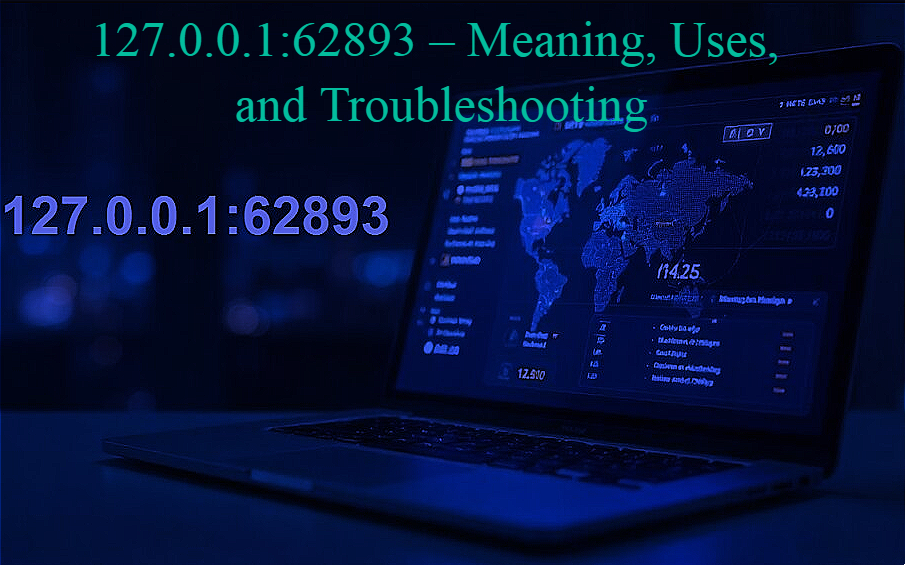In the world of networking, IP addresses, and local servers, you might have come across 127.0.0.1:62893 while working with applications, debugging software, or configuring a local web server. But what does this combination mean? Is it important for your system? In this article, we will dive deep into 127.0.0.1: 62893, exploring its significance, functions, and possible troubleshooting methods.
What is 127.0.0.1:62893?
To understand 127.0.0.1:62893, we need to break it down into two parts:
- 127.0.0.1 – This is the loopback address, commonly referred to as localhost. It is a special IP address that points back to your computer.
- 62893 – This is a port number that is dynamically assigned when an application or service on your system communicates internally.
Together, 127.0.0.1: 62893 represents a local connection used by your operating system, applications, or development tools for internal communication.
Also, explore Mobile Units: Snowbreak Locate Uninterruptible Power Supply on the Go
How Does 127.0.0.1:62893 Work?
When a program runs on your computer, it might need to communicate with another service running on the same device. Instead of sending data through the internet, it uses 127.0.0.1: 62893 to keep the communication within the system.
- The IP address 127.0.0.1 ensures that the data stays inside your computer.
- The port 62893 helps the system differentiate between multiple running services.
For example, a local web server like Apache or NGINX may use a local port like 62893 to test websites before deployment.
Common Uses of 127.0.0.1: 62893
1. Local Development and Testing
Developers use 127.0.0.1: 62893 to run and test applications on their computers before making them live. Web developers, software engineers, and database administrators frequently use it for debugging.
2. Inter-Process Communication (IPC)
Some background services and applications need to communicate with each other locally. They use 127.0.0.1: 62893 to establish secure internal communication without exposing data to external networks.
3. Firewall and Security Monitoring
Firewalls monitor loopback traffic, ensuring no unauthorized connections occur. Cybersecurity tools may analyze traffic on 127.0.0.1: 62893 to detect potential threats.
Is 127.0.0.1:62893 Safe?
Yes, 127.0.0.1: 62893 is safe because it does not interact with external networks. However, security concerns may arise if:
- A malicious program exploits an open port.
- An application fails to close the port properly, leading to potential vulnerabilities.
- A misconfigured firewall allows unauthorized access to a local service.
Troubleshooting 127.0.0.1:62893 Issues
If you experience errors related to 127.0.0.1: 62893, follow these steps to diagnose and fix them:
1. Check for Running Applications
Use the following command to check which application is using port 62893:
- Windows: netstat -ano | findstr :62893
- Linux/macOS: lsof -i :62893
2. Restart the Application
Sometimes, restarting the service using 127.0.0.1:62893 resolves connectivity issues.
3. Check Firewall and Antivirus Settings
Ensure your firewall is not blocking the port. You may need to create an exception for a trusted application.
4. Release the Port Manually
If the port remains occupied, you can manually close it:
- Windows: taskkill /PID [ProcessID] /F
- Linux/macOS: kill -9 [ProcessID]
5. Reconfigure Software Settings
If an application repeatedly fails on 127.0.0.1:62893, check its configuration files for incorrect port settings.
FAQs About 127.0.0.1:62893
1. What does 127.0.0.1:62893 mean?
It refers to a local connection where 127.0.0.1 (localhost) is the IP address, and 62893 is the port number used by an application for internal communication.
2. Why is my application using 127.0.0.1:62893?
Your application likely uses 127.0.0.1:62893 for local development, testing, or internal process communication.
3. Is 127.0.0.1:62893 a security risk?
Generally, it is safe. However, if a malicious application exploits an open port, it can pose a security risk. Always monitor active connections.
4. How can I find out which process is using 127.0.0.1:62893?
Use commands like netstat -ano (Windows) or lsof -i (Linux/macOS) to identify the process occupying the port.
5. Can I change the port number from 62893 to something else?
Yes, most applications allow port customization through their configuration files or settings.
Conclusion
Understanding 127.0.0.1:62893 is crucial for developers, network administrators, and security analysts. This local connection is commonly used for testing, debugging, and internal communication between applications. While it is generally safe, monitoring port activity and ensuring proper firewall configurations can help prevent security risks. By following the troubleshooting steps provided, you can efficiently resolve any issues related to 127.0.0.1:62893.
